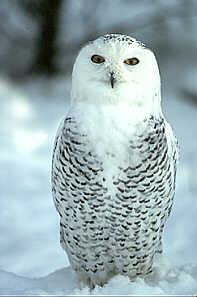Here some general information about the Snowy Owl:
Description: The Snowy Owl is a large, diurnal white Owl that has a rounded head, yellow eyes and black bill. The feet are heavily feathered. Intensity of dark spotting varies with the sex of the immatures, females being the darkest. Juveniles are uniformly brown with scattered white tips of down.
Size: Length 51-68.5 cm (20-27") average female 66cm (26" inches), male 59cm (23")
Wingspan 137-164cm (54-65")
Weight 1134-2000g (40-70oz) average female 1707g (60oz), male 1612g (57oz)
Habits: Snowy Owls are active during the daytime, from dawn to dusk. Snowy Owls are very aggressive when defending their nest.
Hunting & Food:
 Most hunting is done in the "sit and wait" style. These Owls are highly diurnal, although they may hunt at night as well. Prey are captured on the ground, in the air, or snatched off the surface of water bodies.
Most hunting is done in the "sit and wait" style. These Owls are highly diurnal, although they may hunt at night as well. Prey are captured on the ground, in the air, or snatched off the surface of water bodies. They also snatch fish with their talons. Small prey up to small hares are swallowed whole, while larger prey are carried away and torn into large chunks.
Snowy Owls can live at least 9.5 years in the wild and 35 years in captivity. Natural enemies are few - Arctic foxes and wolves prey upon them on their tundra breeding grounds, while skuas and jaegers may take eggs or chicks.
Here a link to learn more about CITES and how many species of plants and animals are endanger :
http://www.cites.org/eng/disc/species.shtml
Also for some of our Canadian viewers there are some more links of wildlife conservation sites:
Wildlife Conservation Society Canada http://www.wcscanada.org/
http://www.mtnviewconservation.org/
World Wildlife Foundation http://wwf.ca/
Enivorment Canada http://www.ec.gc.ca/default.asp?lang=en&n=a730b631-1
Wildlife Preservation Canada http://www.wildlifepreservation.ca/
Canadian Wildlife Federation http://www.cwf-fcf.org/en/index.html
These are just few of the many wildlife conservation sites in Canada and feel free to let me know of more conservation websites that you know of or an endanger species that you would like to be spot lighted more.


No comments:
Post a Comment